Face-Off: Smartphone vs. Mirrorless Camera
As the quality of smartphone cameras improves, they are challenging not only point-and-shoots but also entry-level DSLRs and mirrorless cams.
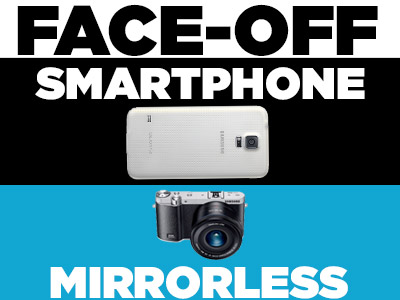
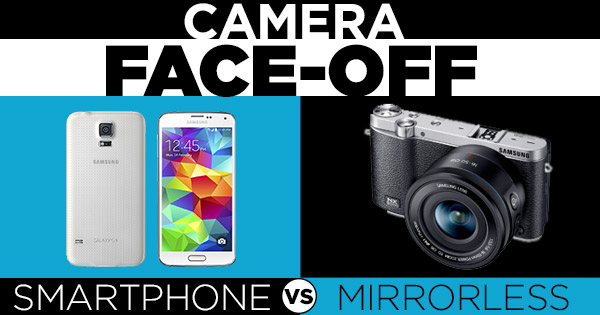
We hear a lot about professional photographers turning to their smartphones to capture images, and how powerful the photographic abilities of these phones have become. We've even heard from pundits that the smartphone has "killed" the DSLR. For the nonpro then, smartphones must be a slam dunk, right? If National Geographic photographers can use their phones for assignments, then soccer dads can, too.
But not everyone believes that the smartphone can handle every professional (or even amateur) photographic task. That made us wonder just how much you might miss (or gain) by using a smartphone as your only camera.
The Contenders
Instead of pitting a phone against a top-end professional camera, we took a look at something that the average consumer could afford. For the smartphone, we picked the Samsung Galaxy S5 ($49 on contract, $540 unlocked). Though it's not the newest smartphone, it is still one of the most popular models and has impressed us with its high-quality images and special photographic features, such as HDR and selective focus.
For the "real" camera, we put aside the issue of brand rivalry and chose another Samsung product, the NX3000. This $350 (with lens) mirrorless camera features interchangeable lens capability, advanced controls and wireless connectivity. There are certainly higher-performance mirrorless cameras — some good enough for professionals. But $350 is still a sizable investment — and for a device that doesn't make calls or surf the Net. What do you get for that price?
MORE: Best Mirrorless Cameras
In one corner, we have the Samsung Galaxy S5, which measures 5.59 x 2.85 x 0.32 inches and weighs 5.11 ounces.

It has a 16-MP 1/2.6-inch sensor with simultaneous HD video and image recording, geotagging, touch focus, face/smile detection and high dynamic range (HDR). It shoots not only full-HD 1920 x 1080 video at 60 frames per second, but also Ultra HD 3840 x 2160 at 30 fps. The lens is fixed at 4.8mm focal length, equivalent to 31mm on a full-frame camera (the unit of measure for comparing lenses) with a fixed aperture of f/2.2. (Aperture affects low-light performance and depth of field, or sharpness, from foreground to background.) The Galaxy S5 has a built-in LED flash, a micro USB slot and (because it's a smartphone) amazing connectivity options using Wi-Fi and 4G LTE. For composition and viewing, the phone has a 5.1-inch Super AMOLED capacitive touch screen with a full-HD resolution of 1080 x 1920 pixels.
In the other corner is the Samsung NX3000, an interchangeable-lens camera complete with a 16-50mm zoom lens, equivalent to about 25-77mm on a full-frame camera, with a maximum aperture of f/3.5-5.6 (which gathers much less light than f/2.2) and an attachable flash.
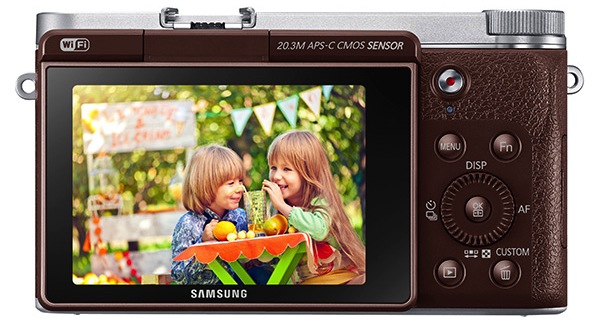
Without the lens or flash, the camera measures 4.62 x 2.6 x 1.54 inches and weighs 8.11 ounces. The lens adds around 2 inches to the front, and a few ounces. The camera has a 20-megapixel APS-C sensor, which is more than 10 times the size of the Galaxy S5's sensor. Its 3-inch LCD screen has a resolution of 480 x 320p (less than standard-definition TV). It shoots full-HD 1920 x 1080p video but at only 30 fps. The camera has Wi-Fi and NFC connectivity.
Based on specs, the NX3000 should take vastly better images than the Galaxy S5, thanks to its larger APS-C sensor. But the Galaxy S5 has a Samsung ISOCELL chip using a BSI (Backside Illuminated) design to increase sensitivity. Plus, the S5 incorporates phase-detect autofocus, which is usually found only on high-end cameras.
The NX3000's interchangeable lens mount makes it more versatile. For the Galaxy S5, if you want a focal length longer or wider than the default 4.8mm in the camera (which corresponds roughly to how your eyes see), you'll need to attach an add-on lens. However, no add-on lens is as versatile as even the most basic lens for the NX3000.
Round 1: Design Differences
When you hold the two devices side by side, it's clear they have different purposes.
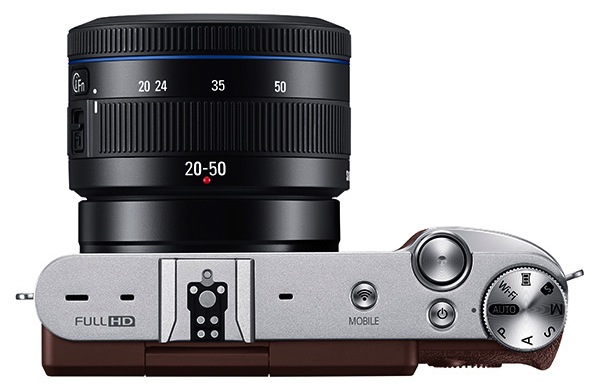
The Galaxy S5 is flat, rounded and comfortable in the palm of the hand. In order to use it as a phone, you have to hold it in what I call the Vulcan Camera Grip — balancing the phone in one hand while trying to hit the on-screen buttons with a finger. To change a setting, it's usually necessary to lower the camera and start tapping. In comparison, the NX3000's small, sculpted grip and bevy of photographic controls at a finger's reach make it a pleasure to use.
The Galaxy S5 also has a touch-screen LCD, allowing shooters to pick a focus point by simply tapping the screen.
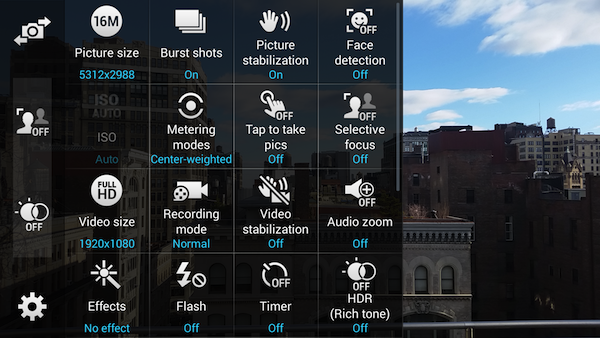
The NX3000 lacks this feature, making autofocus a more complicated proposition. (Many other cameras, including Samsung's higher-end NX300 and NX30, do have touch screens.)
The touch screen cuts both ways here, since the mirrorless camera has dedicated dials and buttons to instantly select different shooting modes and settings. To shoot in aperture priority, simply turn the mode dial to A. Want to shoot a panorama? Turn the dial to Panorama and press the shutter release.
On the phone, accessing any shooting feature requires tapping a menu icon, finding the feature you want to select and sometimes picking another setting farther down in the menus.
Winner: Mirrorless camera. The NX3000 camera wins for better ergonomics and the ability to quickly change settings.
Round 2: Startup and Focus
The Galaxy S5 is much faster to put into play than the NX3000 because the phone is always on. Simply swipe up the camera icon on the lock screen, and the camera instantly locks focus. It has one of the fastest autofocus systems I've seen. The NX3000 takes a few seconds to start up, including to extend the lens. It can't start focusing until the lens is out.
MORE: Camera Wars: Why Autofocus Is the New Megapixel
The Galaxy S5 provides lightning-fast focus, while the NX3000 takes a bit longer to pick its target. The focusing system on the Galaxy S5 is amazing, and it's able to accurately track subjects as they move around. The NX3000 often took several seconds to lock onto a target, especially when I was shooting in low light, because it uses a slower autofocus technology called contrast detection. Higher-end mirrorless cameras have begun to use the kind of high-speed autofocus found in DSLRs, known as phase detection, but most entry-level mirrorless models lack it.
Winner: Smartphone. Startup and focus speed give the Samsung Galaxy S5 the edge here.
Round 3: Creative Control
The Galaxy S5 has fewer controls than the Samsung NX3000. The default Camera app on the phone can't adjust the shutter speed, for example, though there are apps (like Camera FV-5) that provide more direct control over some settings. You can't adjust the aperture on any nearly any camera phone, because each has one, fixed aperture. Focal range is also fixed, usually with an extreme depth of field that makes nearly everything appear sharp.
In this Galaxy S5 photo of a man on a rock, at left, even the buildings far in the background are in sharp focus. I can't adjust the aperture to blur part of the image so that some parts are out of focus, bringing attention to the man, as I did in this photo at right with the NX3000.
(Click on the photo samples below to enlarge them.)
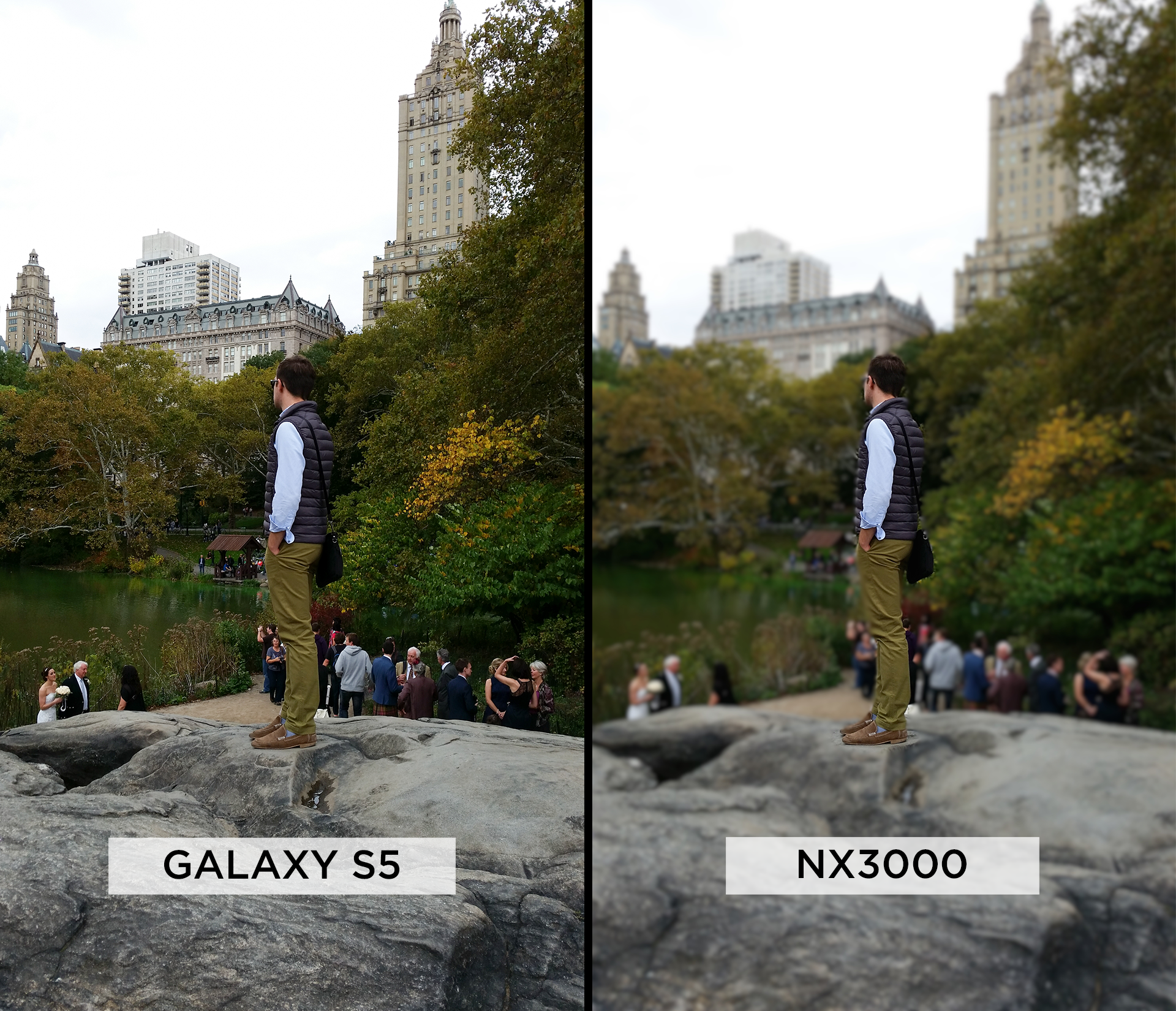
The Galaxy S5's camera app does provide the ability to blur the foreground or background in software. However, it requires careful setup and lacks the natural and soft qualities of a scene blurred with aperture control.

As a real camera, the NX3000 allows a photographer to create a variety of images that are either difficult or impossible with the camera phone. In this case, I created a photo with motion blur but a sharp subject by setting a small aperture, a slow shutter speed and low ISO, and then panning along with moving traffic as I shot.

Winner: Mirrorless camera. The NX3000 provides much more control over the look and feel of an image.
Round 4: Zoom Capability
Focal length is another area where cameras triumph over smartphones. To increase your reach with a smartphone, you need to use digital zoom, which crops the sensor and lowers the overall resolution of the image. With a camera, zoom is achieved by the lens optics, with no reduction in resolution or quality. Because the camera takes a range of interchangeable lenses, it offers more focal-length options than just the 3X zoom of the kit lens.
Here's the view from the same spot with the Galaxy S5 (left), which is fixed at its 31mm (equivalent) focal length. At right is the shot from the NX3000 at the longest zoom possible — 50mm, or a full-frame equivalent of 75mm.
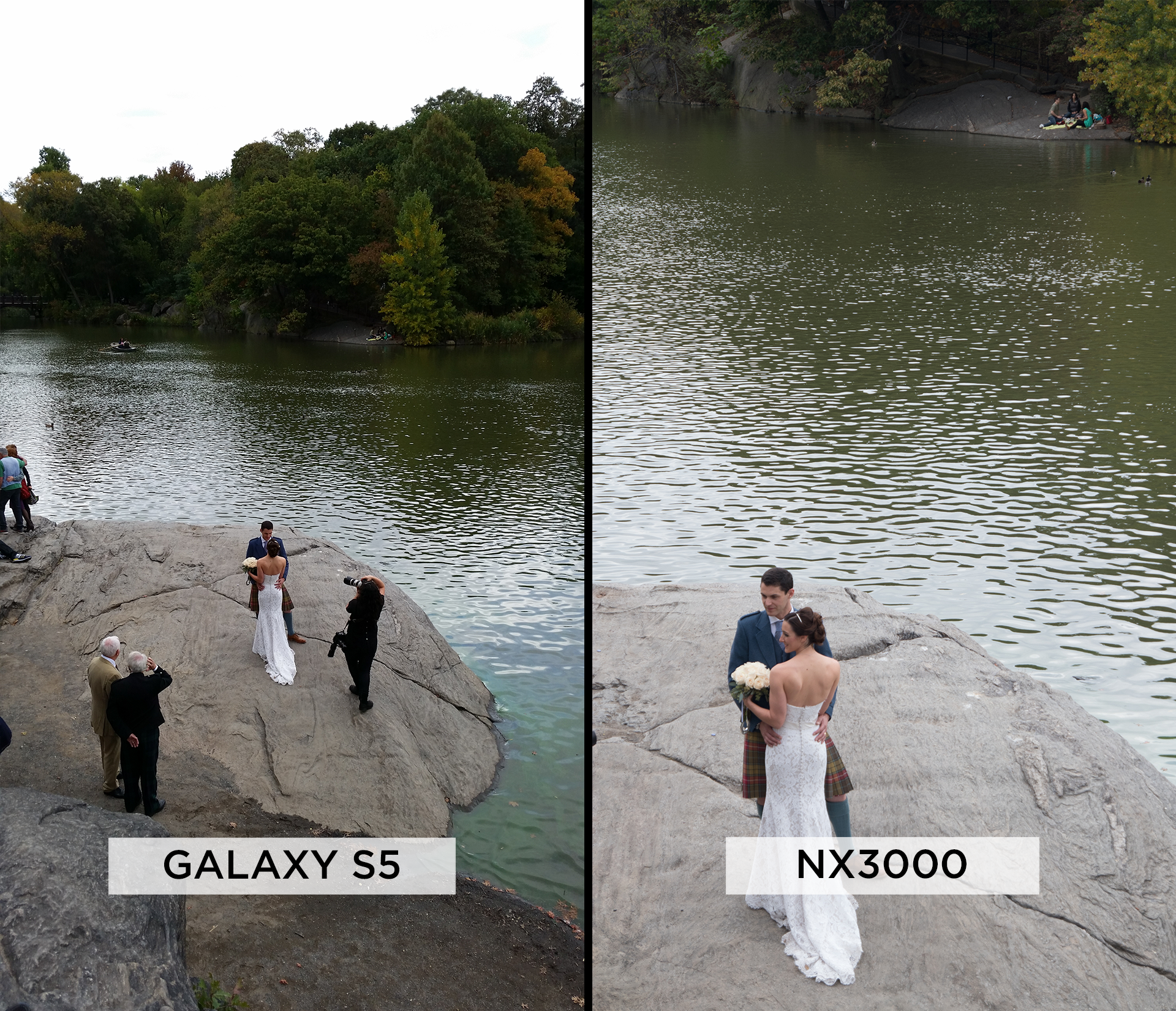
You can pseudo zoom with the Galaxy S5 either beforehand, using the digital zoom or afterward using software to crop the photo, but quality suffers, as you see below.
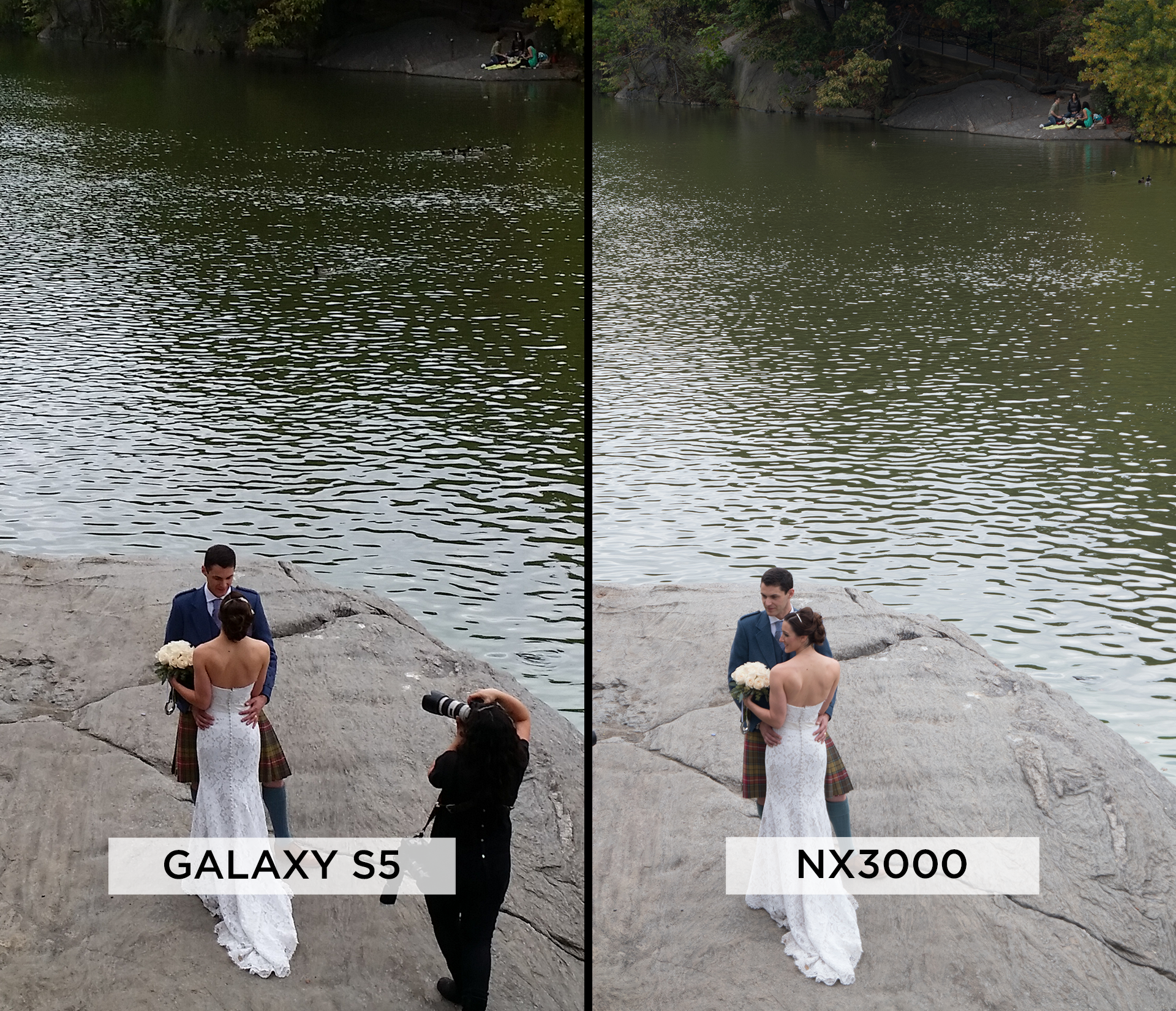
Winner: Mirrorless camera. The NX3000 wins because it can change focal length without losing image quality.
MORE: Best Phone Cameras
Round 5: Color and Sharpness
Overall, the Galaxy S5 produced more vibrant (though often oversaturated) colors, with better sharpness. The image at right is from the NX3000, which has relatively good color saturation and acceptable sharpness. But the Galaxy S5 produced a much sharper image, at left. Look at the details on that metal pipe snaking out under the signs, and the number 17 on the poster.
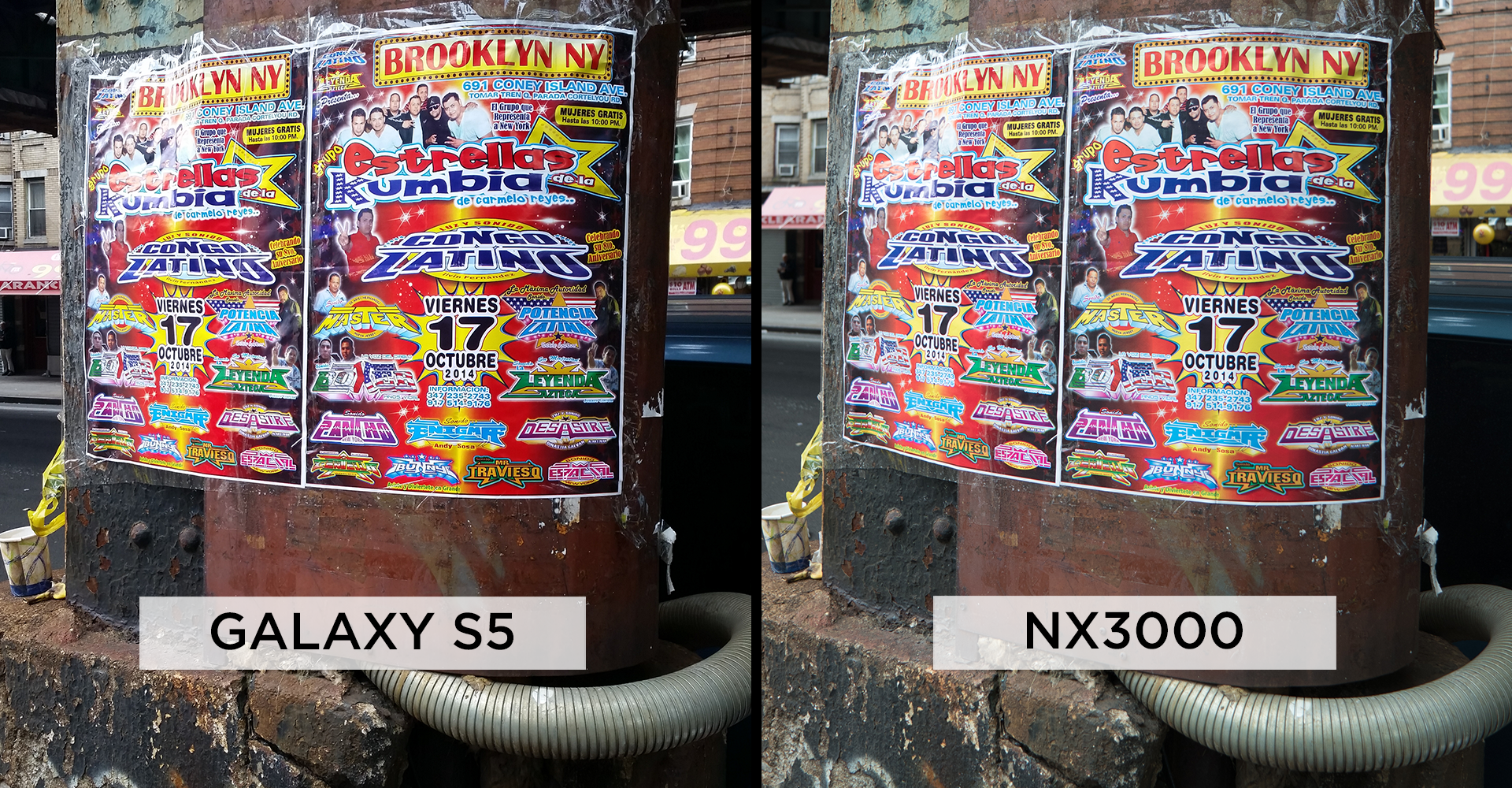
The color saturation is greater and more pleasing in the photo taken by the S5, though the more muted tones of the NX3000 are sometimes - but not always - closer to the original. In this shot from the NX3000, the crayons, tablecloth and skin tones look subdued and not as vibrant as they did in real life. There is an overall flatness to the scene, specifically in the tablecloth and the skin tones.

The Galaxy S5 introduced a bit of an orange cast, but the photo is more vibrant, much sharper and more attractive.

It's important to note that the NX3000 can shoot in not only compressed JPEG files (as the S5 can) but also in the data-rich RAW file format, giving the photographer more control over adjusting the image afterwards in an editing program such as Photoshop.
Winner: Smartphone. The Galaxy S5 produces more vibrant images with better sharpness. However, photographers looking to adjust the images after capture have more options with the RAW support of the NX3000.
Round 6: Low-Light Photos
As expected, the mirrorless camera produced vastly better images in low light due to its larger sensor, which has a greater surface area to gather light.
This Galaxy S5 shot in a hallway in a museum is typical of its low-light performance. The walls surrounding the flag are obviously showing sensor noise (graininess), and the cloth of the flag looks blotchy.(Although as we've seen before, the colors are more vibrant.)

This photo from the NX3000 is at a higher ISO but still shows less noise. What noise it does have is less pronounced, more uniform and constrained mostly to the wall, with the flag looking much better than in the Galaxy S5's shot.

Winner: Mirrorless camera. The NX3000 captured better images in low light, thanks to the larger sensor.
Round 7: Shooting Modes and Options
Both Samsung devices provide some special shooting modes, including Beauty Face (to improve the look of skin tones), Shot & More, Panorama, Virtual Tour and Dual Camera. It's possible to download more (free) modes, like Sports Shot and Animated Photo, to the Galaxy S5. The NX3000 has a wider range of modes — 16 in total — but there isn't any way to download new ones, which is a shame.
Each device also has a few head-scratchers. The Galaxy S5 can "remove" objects like a photobomber in the background, but that feature works by taking a burst of photos, and the unwanted part must not be present in at least one frame. I suppose that if you wanted the smile from one photo but without the elbow of a stranger in the background of another, this feature would be useful, but since you're taking a burst anyhow, you could just as easily pick a shot that doesn't have the unwanted object in it.
Winner: Mirrorless camera. Out of the box, the NX3000 wins, thanks to its wider range of modes and more camera controls available in those modes. The ability to download more modes on the Galaxy S5 is a plus, though.
Round 8: Video
The Samsung Galaxy S5 can record in both full-HD and Ultra HD (sometimes called 4K), the latter of which offers four times the resolution of the HD in the NX3000. For users doing video work, the raw UHD video is an amazing starting point. While UHD video capture isn't yet standard for smartphones or mirrorless systems, more and more devices are capturing in UHD, and more monitors and TVs are displaying it. Having uHD capability in the Samsung Galaxy S5 futureproofs the device, and it means that videos you shoot today will work with tomorrow's TVs.
I evaluated the UHD video on a Dell 24-inch 4K display. The versions we show here have been reduced to HD for Web streaming, which lowers the quality.
MORE: Camera Face-Off: iPhone 5s vs. Galaxy S5
There isn't any image stabilization on the Galaxy S5 while shooting UHD video, so it's necessary to use a tripod adapter to get the best, shake-free footage. However, the HD video mode does offer digital image stabilization. The truth is that neither of these devices is great at capturing video. They both produce video that's grainy and a bit soft, even in bright light.
In this typical situation, the Galaxy S5 video is noticeably brighter and sharper. (Select the 1080p HD play mode, and note that online compression and bandwidth limitations may affect how good these videos look on your screen.)
The NX3000 video is smoother (in terms of motion) but much softer. It's a shame that the NX3000's video quality isn't great because the sensor is so much larger than that in the S5. There are a number of excellent APS-C cameras for video capture on the market, albeit at a higher price, such as the $600 Sony a6000 (see review).
The quality is closer in these two shots of espresso (sorry for the pun), but the NX000 autofocus drifts occasionally.
Galaxy S5
NX3000
Of course the Galaxy S5 also has the ability to output UHD video, though there aren't too many places to share it right now — but it's an option for the near future, when it likely will be common.
Winner: Smartphone. The UHD video produced by the Galaxy S5 is hard to beat because of the exceptional sharpness, even when converted down to HD.
Round 9: Connectivity
Both devices are full of connectivity options, but for obvious reasons, the Galaxy S5 is the champ. With built-in Wi-Fi, LTE and GPS, the smartphone is an always-connected device with an operating system built for sharing and social media. Getting an image from the smartphone camera to Facebook is a one-click affair, and there are plentiful third-party apps to make it easy to share and transmit images.
The NX3000 camera is also well connected, featuring Wi-Fi, but it has to connect to a smartphone or a computer to transfer the photos, which you then upload from those devices.
Winner: Smartphone.
Connectivity is the Raison d'être of a smartphone. Even a camera with well-designed wireless features, such as the NX3000, can't compete.
Overall Winner: Mirrorless camera (by a hair)
For many people, a smartphone is their entry-level camera. And compared to an entry-level model of a "real" camera, a smartphone like the Galaxy S5 is almost as good.
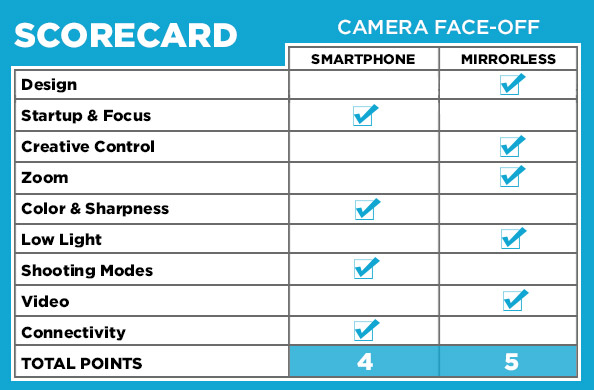
For the photographer who wants the most creative control, the Samsung NX3000 is the better choice — with some caveats. The Galaxy S5 won in our test for color quality, which is a huge deal, but the NX3000 can shoot in RAW — a very important feature for the higher-end photographer. While the Galaxy had more vibrant and shaper images, with a RAW file and editing software, a photographer can make even better-looking images from the NX3000. The NX3000 also offers far more creative control, with the ability to adjust aperture and change lenses, for example. Some of the image-quality issues we saw, such as softness, may be due to the mediocre kit lens.
The Samsung Galaxy S5 provides many of the features found in more powerful cameras, and it doubles as a telephone that's available and ready to shoot whenever the creative mood strikes. Since the image quality in regular lighting conditions is better, it's hard not to love this phone.
The choice will come down to which device's strong points you value more. But our tests show that, to some degree, the camera phone really can replace a stand-alone camera.
• DSLR vs. Mirrorless Cameras: Which Is Better for You?
• Canon G7 X Bridge Camera Review: Compact Champ
David Schloss has been a professional photographer and technology writer for more than 20 years. Follow him @davidjschloss. Follow us @TomsGuide, on Facebook and on Google+.
Sign up to get the BEST of Tom's Guide direct to your inbox.
Get instant access to breaking news, the hottest reviews, great deals and helpful tips.
-
iamdisappoint You also faked the image of one of the first photos of the guy on the rock. It has been artificially blurred around the guy to create bokeh. If it was a real photo the rock he is standing on would be sharp in line with where is standing. Not only that but you can see where you used the blur tool a bit too aggressively and blurred out the rims of his sunglasses.Reply
Not only that but the perspective is exactly the same as the Samsung one, not only that, but the bride and her father are in the exact same position in the background. I would assert that you have just taken the Samsung photo and edited in some fake background blur and lied that it was the mirrorless camera.
Hard to take your article or your site seriously when you are faking photos in comparison articles...

